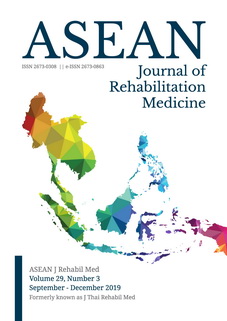Trigger Point Injection with 1% versus 2% Lidocaine for Treatment of Myofascial Pain Syndrome at Neck and Upper Back: A Randomized Controlled and Double-blinded Clinical Trail
Keywords:
myofascial pain syndrome, neck, upper back, injection, lidocaineAbstract
Objectives: To study and compare the effectiveness of trigger point injection with 1% versus 2% lidocaine for treatment of myofascial pain syndrome (MPS) at neck and upper back.
Study design: Randomized controlled and double-blinded clinical trial.
Setting: King Mongkut Memorial Hospital, Phetchaburi Province, Thailand.
Subjects: Patients with MPS at neck and/or upper back not more than 6 months
Methods: There were 30 patients treated with 1% lidocaine trigger point injection, and 31 patients with 2% lidocaine. Pain score, pressure pain threshold, post injection soreness, active range of motion (AROM) of neck, and quality of life (QoL) before and after treatment, were compared within the same group and between the two groups at different times after treatment.
Results: Immediately after treatment, 1 week, 2 weeks and 4 weeks after treatment, there were significant decrease in pain score, increases in pressure pain threshold and AROM of neck in both groups (p ≤ 0.05), but there were no differences between the two groups (p > 0.05). There was no difference in post injection soreness between 2 groups (p > 0.05). At 4 weeks after treatment, QoL in the components of physical functioning, role limitation due to physical problems, and bodily pain were significantly increase in both groups (p ≤ 0.05), but there was no difference between the two groups (p > 0.05).
Conclusion: There was no evidence of higher effectiveness of 2% over 1% lidocaine trigger point injection in treating patients with myofascial pain at neck and upper back. Thus 1% lidocaine is recommended for trigger point injection because it is safer for patients and more economical.
References
2. Fricton JR, Kroening R, Haley D, Siegart R. Myofascial pain
syndrome of the head and neck: A review of clinical characteristics of 164 patients. Oral Surg. 1985;60:615-23.
3. Skootsky S. Incidence of myofascial pain in an internal medical group practice. Presented to the American Pain Society, Washington DC, November 6-9, 1986.
4. Simon DG. Myofascial pain syndrome due to trigger point. In: Goodgold J, editor. Rehabilitation Medicine. St. Louis: Mosby; 1988. p. 686-723.
5. Preteepavanich P. Myofascial pain syndrome. Bangkok: Amarin Printing and Publishing PCL; 2016.
6. Yuadyong M, Reiwpaiboon W, Prateepavanich P. Immediate effect of myofascial trigger point injection measured by pain threshold and pain score. J Thai Rehabil Med. 1994;4:15-9.
7. Stein JB, Simon DG. Myofascial pain. Arch Phys Med Rehabil. 2002;83:S40-5.
8. Hong CZ. Muscle pain syndromes. In: Braddom RL, editor. Physical medicine and rehabilitation. 4th ed. Philadelphia: WB Saunders, 2011. p. 971-1001.
9. Alvarez DJ, Rockwell PG. Trigger points: diagnosis and management. Am Fam Physician. 2002;65:653-60.
10. Desai MJ, Saini V, Saini S. Myofascial pain syndrome: a treatment review. Pain Ther. 2013;2:21-36.
11. Kamolsawad N, Piravej K. Comparison of efficacy between dry needling and 1% xylocaine injection in myofascial trigger point treatment on neck and upper back. J Thai Rehabil Med. 2005; 15:88-100.
12. Cummings TM, White AR. Needling therapies in the management of myofascial trigger point pain: a systematic review. Arch Phys Med Rehabil. 2011;82:986-92.
13. Rozanski RJ, Primosch RE, Courts FJ. Clinical efficacy of 1% and 2% solutions of lidocaine. Pediatr Dent. 1988;10:287-90.
14. Jorkjend L, Skoglund LA. Comparison of 1% and 2% lidocaine hydrochloride used as single local anesthetic: effect on postoperative pain course after oral soft tissue surgery. Exp Clin Pharmacol. 1999;21:505-10.
15. Hong CZ. Lidocaine injection versus dry needling to myofascial trigger point. The importance of the local twitch response. Am J Phys Med Rehabil. 1994;73:256-63.
16. Gupta P, Signh V, Sethi S, Kumar A. A comparative study of trigger point therapy with local anesthetic (0.5% bupivacaine) versus combined trigger point injection therapy and levosulpiride in the management of myofascial pain syndrome in the orofacial region. J Maxillofac Oral Surg. 2016;15:376-83.
17. Kim SA, Oh KY, Choi WH, Kim IK. Ischemic compression after trigger point injection affect the treatment of myofascial trigger points. Ann Rehabil Med. 2013;37:541-6.
18. Dhadwal N, Hangan MF, Dyro FM, Zeman R, Li J. Tolerability and efficacy of long term lidocaine trigger point injections in patients with chronic myofascial pain. Int J Phys Med Rehabil. 2013;S1:004.
19. Eroglu PK, Yilmaz O, Bodur H, Ates C. A comparison of the
efficacy of dry needling, lidocaine injection, and oral flurbiprofen treatments in patients with myofascial pain syndrome: A double-blind (for injection, groups only), randomized clinical trial. Turk J Rheumatol. 2013;28:38-46.
20. Yunus MB. Fibromyalgia syndrome and myofascial pain syndrome: clinical features, laboratory test, diagnosis and pathophysiologic mechanisms. In: Rachlin ES, editor. Myofascial pain and fibromyalgia: Trigger point management. 2nd ed. St. Louis: Mosby; 2002. p. 1-30.
21. Walfe F, Fitzcharles MA, Hauser W, Mease PJ, Russell IJ, Clauw DJ, et al. 2016 Revisions to the 2010/2011 fibromyalgia diagnostic criteria. In: Seminars in arthritis and rheumatism [Internet]. [cited 2018 September 10]. Available from http://www.researchgate.net/publication/307894448
22. Park GB, Kim CW, Park SB, Kim MJ, Jang SH. Reliability and usefulness of the pressure pain threshold measurement in patients with myofascial pain. Ann Rehabil Med. 2011;35:412-7.
23. Leurmarnkul P, Meetam P. Properties testing of the retranslated SF-36 (Thai version). Thai J Pharm Sci. 2005;29:69-88.
24. Lugo LH, Garcia HI, Rogers HL, Plata JA. Treatment of myofascial pain syndrome with lidocaine injection and physical therapy, alone or in combination: a single blind, randomized, controlled clinical trial. BMC Musculoskelet Disord 2016;17:101-11.
25. Becker DE, Reed KL. Local anesthetics: review of pharmacological considerations. Anesth Prog. 2012;59:90-102.






